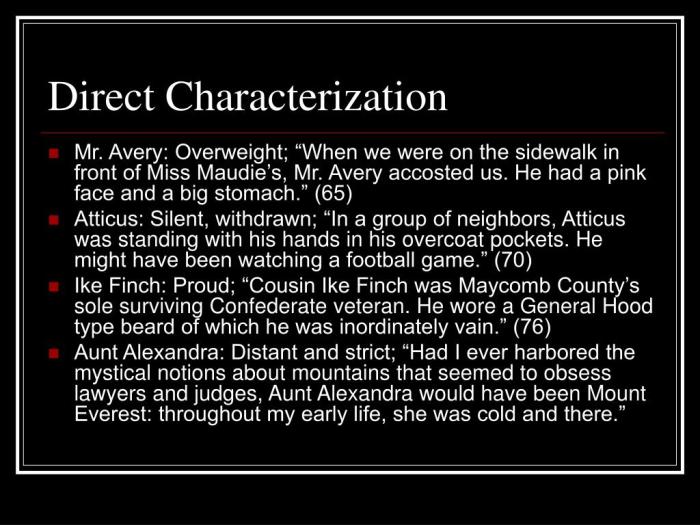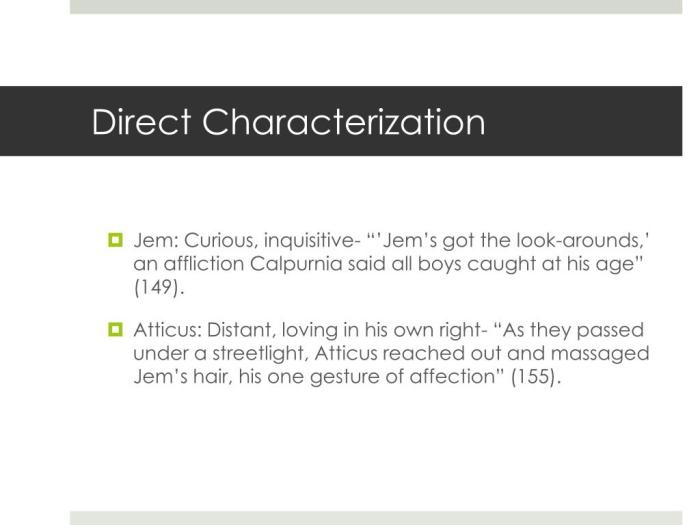Indirect characterization in to kill a mockingbird – In Harper Lee’s classic novel “To Kill a Mockingbird,” indirect characterization plays a pivotal role in revealing the complexities of its characters. This nuanced technique allows the reader to gain profound insights into the personalities, motivations, and values of the individuals within the story.
Through actions, dialogue, physical descriptions, interactions, thoughts, and the setting, Lee masterfully weaves a tapestry of characterization that transcends mere description, inviting the reader to actively engage with and interpret the characters.
Indirect Characterization in To Kill a Mockingbird

Indirect characterization is a literary technique used to reveal the traits and personalities of characters through their actions, dialogue, appearance, and interactions with others. In Harper Lee’s classic novel, To Kill a Mockingbird, indirect characterization plays a crucial role in developing the memorable characters that inhabit the fictional town of Maycomb, Alabama.
Characterization through Actions
Actions and behaviors provide valuable insights into a character’s personality. In To Kill a Mockingbird, Atticus Finch’s actions demonstrate his integrity, courage, and unwavering commitment to justice. Despite the social pressure and prejudice surrounding him, Atticus defends Tom Robinson, a black man falsely accused of rape, demonstrating his unwavering belief in equality and fairness.
Dialogue and Language
Dialogue and language reveal character traits through the words characters speak and the way they speak them. Scout Finch’s intelligent and perceptive observations, expressed through her witty and often humorous dialogue, highlight her sharp mind and independent spirit. Boo Radley’s limited vocabulary and hesitant speech patterns, on the other hand, suggest his social isolation and shyness.
Appearance and Physical Description
Physical appearance and descriptions contribute to indirect characterization by providing visual cues about a character’s personality and background. Bob Ewell’s unkempt appearance and foul odor reflect his poverty and moral decay, while Miss Maudie Atkinson’s colorful garden and vibrant personality symbolize her warmth and resilience.
Interactions with Others
Characters’ interactions with others reveal their true nature. Jem Finch’s protective behavior towards his younger sister, Scout, demonstrates his loyalty and maturity, while Mayella Ewell’s manipulative attempts to frame Tom Robinson highlight her desperation and bitterness.
Thoughts and Internal Monologues
Thoughts and internal monologues provide a glimpse into a character’s inner world. Scout’s insightful observations and moral dilemmas, revealed through her internal monologue, showcase her intelligence and empathy. Atticus’s quiet reflections on justice and equality, expressed through his thoughts, highlight his wisdom and compassion.
Setting and Environment
The setting and environment can influence character development. The oppressive heat and stifling atmosphere of Maycomb contribute to the tension and prejudice that shape the characters’ actions and beliefs. The Radley Place, a mysterious and isolated mansion, symbolizes the secrets and isolation that haunt the town.
Comparison and Contrast, Indirect characterization in to kill a mockingbird
Comparing and contrasting characters can enhance our understanding of their motivations and personalities. Scout and Jem, despite their age difference, share a strong sense of justice and a desire to stand up for what is right. Bob Ewell and Atticus Finch, on the other hand, represent the stark contrast between good and evil in the novel.
FAQ Insights
What is the significance of indirect characterization in “To Kill a Mockingbird”?
Indirect characterization allows readers to actively participate in the interpretation of characters, fostering a deeper understanding of their motivations, values, and complexities.
How does dialogue contribute to indirect characterization in the novel?
Dialogue reveals characters’ thoughts, feelings, and beliefs, providing insights into their personalities and relationships with others.
What role does physical appearance play in indirect characterization?
Physical descriptions can symbolize character traits, hint at past experiences, and foreshadow future developments.



